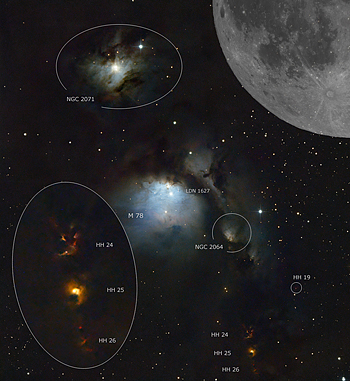 |
CHAMÄLEON + ONJALA OBSERVATORY DeepSky | SITEMAP HOME CHAMÄLEON |
|
 |
|||
| « zurück zur Startseite
galaktische Nebel « back to home galactic nebula |
Großes Bild laden - load large
image 2048 x 1400 Pixel Aufnahmedaten Image data |
Messier 78 78, NGC 2071, 20664, 2067, LDN 1672 and the Herbig Haro objects HH 24, 25 and 26

Messie 78 - Unser Bild zeigt ein 2-er Mosaik der staubigen Region um Messier 78. Eingebettet in die dichte dunkle Molekülwolke Orion B mit reichlich Staub und kaltem Gas - liegt ein Komplex aus mehreren bläulichen Reflexionsnebeln. Während bei Emissionsnebeln durch Ionisation energiereicher Sterne Gaswolken zum leuchten angeregt werden, reflektieren die Gasmassen bei Reflexionsnebeln nur das Licht heller Sterne. Die Entfernung zum Sonnensystem beträgt etwa 1500 bis 1600 Lichtjahre.
Die beiden hellen Sterne HD 38563 A und HD 38563 B erzeugen einen Hauptteil des Lichts, welches die Reflexionsnebel beleuchten. Der Nebel beherbergt aber noch viele weitere Sterne, unter anderem eine Ansammlung von 45 massearmen sehr jungen Sternen, so genannten T-Tauri-Sternen, die sich hinter den dichten Staubwolken verbergen und nur im infraroten Licht beobachtbar sind.
Südlich von NGC 2064 zeigt unser Bild 3 so genannte Herbig Haro Objekte HH 24, 25 (BE 106) und 26. HH 24 besteht aus einer kleinen Gruppe junger Sterne. Es sind sehr junge Sterne, die Materiewolken abstoßen welche dann mit umliegenden Staubwolken interagieren. Ihre Farbe ist rötlich, bedingt durch eine starke Emission im Schwefellicht (S-II). HH 25 enthält einen jungen T-Tauri Stern. T-Tauri Sterne sind extrem junge Sterne, die weniger als 1 Million Jahre alt sind. Aufgrund ihres geringen Alter sind diese Sterne noch nicht stabil und meist irregulär veränderlich.
Die Region wurde übrigens nicht von Charles Messier entdeckt, sondern im März 1780 vom französischen Astronomen und Geographen Pierre Méchain. Messier übernahm die Region später in seinen Katalog. Eine Weitwinkelansicht zeigen wir hier und eine ausführliche Beschreibung von M 78 hier.
Object description
Messier 78 - Our image shows a 2-part mosaic of the dusty region around Messier 78. Embedded in the dense dark molecular cloud Orion B with plenty of dust and cold gas - lies a complex of several bluish reflection nebulae. While in emission nebulae gas clouds are excited to glow by the ionization of energetic stars, the gas masses in reflection nebulae only reflect the light of bright stars. The distance to the solar system is about 1500 to 1600 light years.
The two bright stars HD 38563 A and HD 38563 B produce the majority of the light that illuminates the reflection nebulae. However, the nebula is also home to many other stars, including a collection of 45 very young, low-mass stars, known as T Tauri stars, which are hidden behind the dense dust clouds and can only be observed in infrared light.
Southward of NGC 2064, our image shows 3 so-called Herbig Haro objects HH 24, 25 (BE 106) and 26. HH 24 consists of a small group of young stars. They are very young stars that eject clouds of matter which then interact with surrounding dust clouds. Their color is reddish, due to a strong emission in sulfur light (S-II). HH 25 contains a young T Tauri star. T Tauri stars are extremely young stars that are less than 1 million years old. Due to their young age, these stars are not yet stable and are usually irregularly variable.
 |
 |
Incidentally, the region was not
discovered by Charles Messier, but in March 1780 by the French astronomer and
geographer Pierre Méchain. Messier later included the region in his
catalog. We show a wide-field view
here and a detailed description of Messier 78
here. « Das Bild links zeigt eine detaillierte Ansicht des Herbig Haro Objekts HH 24, aufgenommen mit dem Hubble Weltraumteleskop. « The image on the left shows a detailed view of the Herbig Haro object HH 24, taken with the Hubble Space Telescope. « « Klicken Sie hier oder auf das Vorschaubild zum Laden eines großen Bildes mit Objektbezeichnungen. « « Click here or on the thumbnail to load a large image with object annotations. |
Messier 78 78, NGC 2071, 20664, 2067, LDN 1672 and the Herbig Haro objects HH 24, 25 and 26
Image data
09-14.04.2023 - total 30 x 600 s, QHY ALccd 12 (cooled)
Telescope: PlaneWave CDK 12.5" Astrograph + 0.8x Reducer at f = 2030 mmm
Location: Chamäleon Observatory, Onjala Lodge, Namibia
Image acquisition and processing: DeepSkyStacker, PixInsight + Photoshop
 |
 |
 |
 |
 |
 |
 |
| Sonne | Mond | Sonnensystem | DeepSky | Weitwinkel | Verschiedenes | Spez. Projekte |